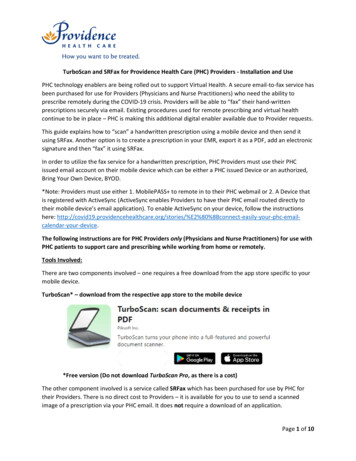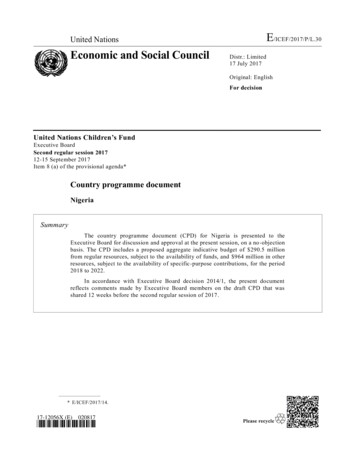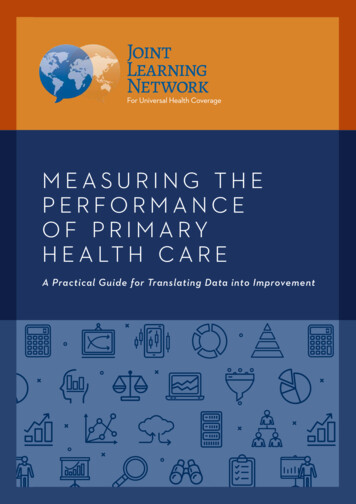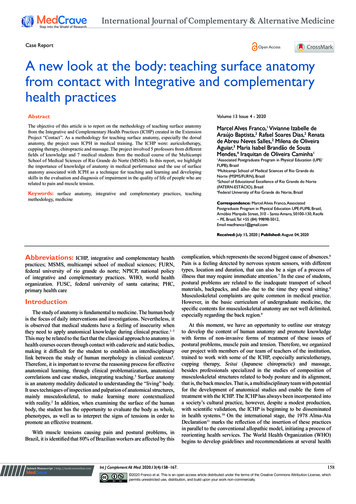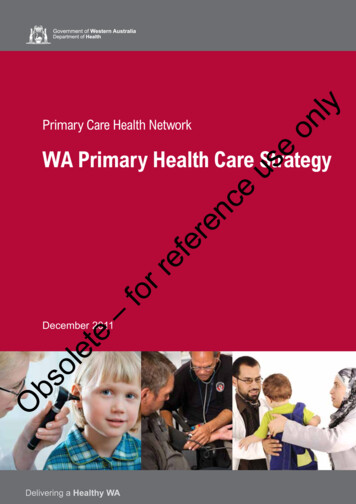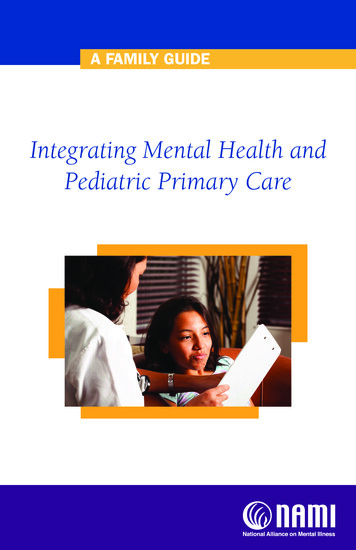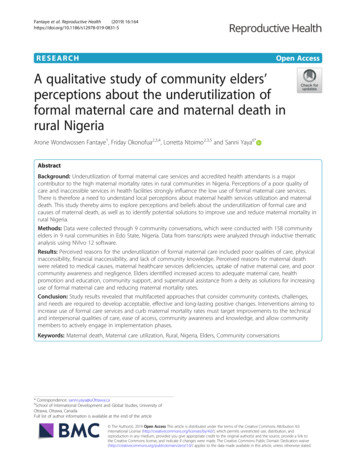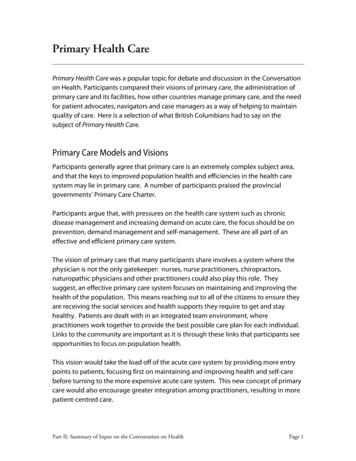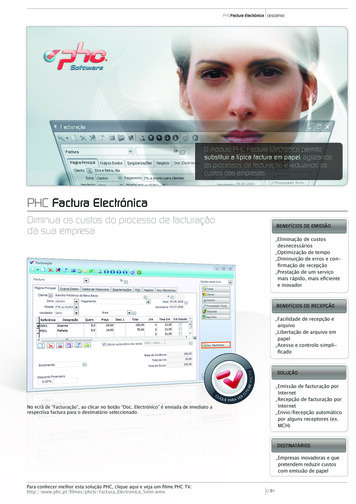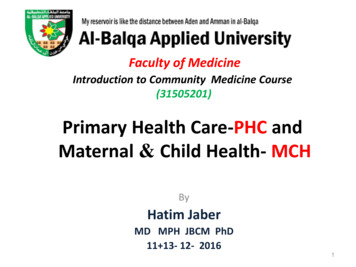
Transcription
Faculty of MedicineIntroduction to Community Medicine Course(31505201)Primary Health Care-PHC andMaternal & Child Health- MCHByHatim JaberMD MPH JBCM PhD11 13- 12- 20161
Presentation outlineTimeIntroduction and Definitions12:00 to 12:10Levels of health care12:10 to 12:30Principles and elements of PHC12:30 to 12:50Maternal and Child Health- MCHNext lecture2
Declaration of Alma-Ata International Conference on PrimaryHealth Care, Alma-Ata, USSR, 6-12 September 1978Primary Health Care (PHC) PHC is:Essential health care based on practical,scientifically sound and socially acceptablemethods and technology made universallyaccessible to individuals and families in thecommunity through their full participationand at a cost that community and the countrycan afford (Alma-Ata, 1978)
PHC DefinitionPHC is an essential health care that is a socially appropriate, universally accessible, scientifically sound first level careprovided by a suitably trained workforcesupported by integrated referral systemsand in a way that gives priority to those most inneed, maximises community and individualself-reliance and participation and involvescollaboration with other sectors.
What is Primary Health Care?PHC is essential health care that is a socially appropriate,universally accessible, scientifically sound first level careprovided by a suitably trained workforce supported byintegrated referral systems and in a way that gives priority tothose most in need, maximises community and individual selfreliance and participation and involves collaboration withother sectors. It includes the following: health promotion illness prevention care of the sick advocacy community development
Comprehensive primaryhealth care Social justice and equityCommunity controlSocial changeManages factors that generate ill healthInvolves an approach to health care overa continuum from health promotion toillness treatment
Comprehensive primaryhealth care– Complete physical, mental and social wellbeing– Addresses issues of equity and social justice– Considers the impact of education, housing, food andincome– Acknowledges the value of community development– Recognises the expertise of individuals over theirown healthTalbot and Verinder 2005
Models of primary health careComprehensiveSelectiveMedical modelView of healthPositive wellbeingAbsence of diseaseAbsence of DiseaseLocus of controlover healthCommunities andindividualsHealth professionals MedicalpractitionersMajor focusHealth throughequity andcommunitydevelopmentHealth throughmedicalinterventionsDisease eradicationthrough medicalinterventionsHealth careprovidersMultidisciplinaryteamsDoctors plus otherhealth professionalsDoctorsStrategies for onsMedicalinterventionsRogers W. & Veale, B. (2000).
Core Activities for PHCThere is a set of CORE ACTIVITIES, which were normally definednationally or locally. According to the 1978 Declaration of AlmaAta proposed that these activities should include:1. Education concerning prevailing health problems and themethods of preventing and controlling them2. Promotion of food supply and proper nutrition3. An adequate supply of safe water and basic sanitation4. Maternal and child health care, including family planning5. Immunization against the major infectious diseases6. Prevention and control of locally endemic diseases7. Appropriate treatment of common diseases and injuries8. Basic laboratory services and provision of essential drugs.9. Training of health guides, health workers and health assistants.10. Referral services
WHO and Primary Health Care PHCThe ultimate goal of primary health care is better health for all.WHO has identified five key elements to achieving that goal: reducing exclusion and social disparities in health (universalcoverage reforms); organizing health services around people's needs andexpectations (service delivery reforms); integrating health into all sectors (public policy reforms); pursuing collaborative models of policy dialogue (leadershipreforms); and increasing stakeholder participation.
WHO Strategies of PHC1. Reducingexcess mortality of poor marginalizedpopulations:PHC must ensure access to health services for themost disadvantaged populations, and focus oninterventions which will directly impact on themajor causes of mortality, morbidity and disabilityfor those populations.2. Reducing the leading risk factors to human health:PHC, through its preventative and health promotionroles, must address those known risk factors, whichare the major determinants of health outcomes forlocal populations.
WHO Strategies of PHC cont.3. Developing Sustainable Health Systems:PHC as a component of health systems mustdevelop in ways, which are financially sustainable,supported by political leaders, and supported bythe populations served.4, Developing an enabling policy and institutionalenvironment:PHC policy must be integrated with other policydomains, and play its part in the pursuit of widersocial, economic, environmental and developmentpolicy.
Defining primary health care Primary Health Care is not Primarycare alone. Primary, secondary and tertiary arelevels of care
Declaration of the Alma Ata Released in 1978 and consisted of tenfundamental principles for effectivecomprehensive primary health care servicedelivery Principles were in response to the broadercommunity and social issues leading to poorpopulation health
Primary health care (PHC) became a core policyfor the World Health Organization with the AlmaAta Declaration in 1978 and the ‘Health-for-All bythe Year 2000’ Program. The commitment to global improvements inhealth, especially for the most disadvantagedpopulations, was renewed in 1998 by the WorldHealth Assembly. This led to the ‘Health-for-All forthe twenty-first Century’ policy and program, withinwhich the commitment to PHC development isrestated.
The Ottawa Charter Building healthy public policy Creating environments which supporthealthy living Strengthening community action Developing personal skills Reorientating health careThe Ottawa Charter for Health Promotionwas developed in 1986
Characteristics of Primary Health Care (a) Stresses prevention rather than cure. (b) Relies on home self-help, community participation andtechnology that the people find acceptable, appropriate andaffordable. (c) Combines modern, scientific knowledge and feasiblehealth technology with acceptable, effective traditionalhealing practices. (d) Should be shaped around the life patterns of thepopulation. (e) Should both meet the needs of the local community andbe an integral part of the national health care system. (f) Should be formulated and implemented with involvementof the local population.
To SummarizePrimary care is an approach that: Focuses on the person not the disease,considers all determinants of health Integrates care when there is more than oneproblem Uses resources to narrow differences
The Basic Requirements for Sound PHC(the 8 A’s and the 3 lityAcceptabilityAffordability venessContinuity
Appropriateness Whether the service is needed at all inrelation to essential human needs, prioritiesand policies. The service has to be properly selected andcarried out by trained personnel in theproper way.Adequacy The service proportionate to requirement. Sufficient volume of care to meet the needand demand of a community
Affordability The cost should be within the means andresources of the individual and the country.Accessibility Reachable, convenient services Geographic, economic, cultural accessibility
Acceptability Acceptability of care depends on a variety offactors, including satisfactory communicationbetween health care providers and thepatients, whether the patients trust this care,and whether the patients believe in theconfidentiality and privacy of informationshared with the providers.
Availability Availability of medical care means that carecan be obtained whenever people need it.AssessabilityAssessability means that medical care can bereadily evaluated.AccountabilityAccountability implies the feasibility of regularreview of financial records by certified publicaccountants.
Completeness Completeness of care requires adequate attentionto all aspects of a medical problem, includingprevention, early detection, diagnosis, treatment,follow up measures, and rehabilitation.ComprehensivenessComprehensiveness of care means that care isprovided for all types of health problems.ContinuityContinuity of care requires that the management ofa patient’s care over time be coordinated amongproviders.
Primary Health CareCurative servicesPreventive servicesOutpatient clinic (referral)General servicesCare of vulnerable groupsLaboratory servicesHealth educationMonitoring ofenvironmentPrev.&control ofendemic diseasesHealth officeservicesMaternal &child health .School health servicesGeriatric healthservicesOccupationalhealth servicesDispensaryFirst aid and emergencyservices
Levels of Care Primary healthcare Secondary healthcare Tertiary healthcare
Levels of Health Care nuing
Preventive and Primary Care Settings School health servicesOccupational health servicesPhysicians’ officesClinicsNursing centers
Secondary and Tertiary Care Settings Hospitals/medical centers– Emergency departments– Medical units– Intensive care Psychiatric facilities Rural hospitals
Restorative Care Settings Home health care Rehabilitation centers Extended care facilities
Why PHCPrimary health care The “first” level of contact between the individualand the health system. Essential health care (PHC) is provided. A majority of prevailing health problems can besatisfactorily managed. The closest to the people. Provided by the primary health centers.
Secondary health care More complex problems are dealt with.Comprises curative servicesProvided by the district hospitalsThe 1st referral levelTertiary health care Offers super-specialist care Provided by regional/central level institution. Provide training programs
Primary Health Care
Elements of PHC Education concerning prevailing healthproblems and the methods of preventing andcontrolling them Promotion of food supply and proper nutrition Monitoring an adequate supply of safe waterand basic sanitation Maternal and child health care, including familyplanning Immunization against the major infectiousdiseases
Elements of PHC (cont.) Prevention and control of locally endemicdiseases Appropriate treatment of common diseasesand injuries Basic laboratory services and provision ofessential drugs. Training of health guides, health workers andhealth assistants. Referral services
Elements of PHC (cont.) Mental health Physical handicaps Health and social care of the elderly
Principles for PHC PHC based on the following principles :–––––Social equityNation-wide coverageSelf-relianceInter-sectoral coordinationPeople’s involvement in the planning andimplementation of health programs
Principles of PHCThe 1978 Declaration of Alma-Ata proposed a set ofPRINCIPLES for primary health care. PHC should:1. “Reflect and evolve from the economic conditions and sociocultural and political characteristics of the country and itscommunities, and be based on the application of the relevantresults of social, biomedical and health services research andpublic health experience”2. “Address the main health problems in the community,providing promotive, preventive, curative and rehabilitativeservices accordingly”
3. “Involve, in addition to the health sector, all relatedsectors and aspects of national and communitydevelopment, in particular agriculture, animalhusbandry, food, industry, education, housing, publicworks,4. “Promote maximum community and individual selfreliance and participation in the planning,organization, operation and control of primary healthcare, making fullest use of local, national and otheravailable resources; and to this end develop throughappropriate education the ability of communities toparticipate”
5. “Be sustained by integrated, functional and mutuallysupportive referral systems, leading to theprogressive improvement of comprehensive healthcare for all, and giving priority to those most in need”6. “Rely, at local and referral levels, on health workers,including physicians, nurses, midwives, auxiliaries andcommunity workers as applicable, as well astraditional practitioners as needed, suitably trainedsocially and technically to work as a health team andto respond to the expressed health needs of thecommunity.”
The Four Pillars ofPrimary Health Care CommunityParticipation AppropriateTechnology Inter-SectoralCoordination EquitableDistribution
Maternal and Child Health Mothers and children are bothvulnerable groups of the community. Women in the childbearing period (1549 years) constitute about 25% of thepopulation. Children on the other hand constituteabout 40% to 45% of the population indeveloping countries. In Jordan ? This group is characterized by relativehigh mortality and morbidity rates.
Maternal and child health.HEALTHCHILDMOTHERSOCIETYHealthy children need healthy mothers
65 4%15-6462%0-1434%
Age Structureof Jordan’s Population (2015)65 4%15-6462%0-1434%Source: Jordan in Numbers, Department of Statistics, 2015.
According to 2015 WHOestimations it was concluded that: Maternal mortality is unacceptably high.About 830 women die from pregnancy- orchildbirth-related complications around theworld every day. It was estimated that in 2015, roughly303 000 women died during and followingpregnancy and childbirth. Almost all of these deaths occurred in lowresource settings, and most could have beenprevented
Maternal Health Every day, approximately 830 women die from preventable causesrelated to pregnancy and childbirth. 99% of all maternal deaths occur in developing countries. Maternal mortality is higher in women living in rural areas andamong poorer communities. Young adolescents face a higher risk of complications and death asa result of pregnancy than other women. Skilled care before, during and after childbirth can save the livesof women and newborn babies. Between 1990 and 2015, maternal mortality worldwide droppedby about 44%. Between 2016 and 2030, as part of the Sustainable DevelopmentGoals, the target is to reduce the global maternal mortality ratioto less than 70 per 100 000 live births.
Maternal Mortality Nearly 2/3rds of maternaldeaths worldwide resultsfrom five causes: Hemorrhage (24%) Obstructed labor (8%) Eclampsia (pregnancyinduced hypertension)(12%) Sepsis (15%) Unsafe abortion (13%)The other 1/3rd ofmaternal deathsworldwide results fromindirect causes or anexisting medical conditionmade worse by pregnancyor delivery: Malaria Anemia Hepatitis AIDS Tuberculosis Malnutrition
Why do women die? Women die as a result of complications during and followingpregnancy and childbirth. Most of these complications developduring pregnancy and most are preventable or treatable.Other complications may exist before pregnancy but areworsened during pregnancy, especially if not managed as part ofthe woman’s care. The major complications that account fornearly 75% of all maternal deaths are: severe bleeding (mostly bleeding after childbirth) infections (usually after childbirth) high blood pressure during pregnancy (pre-eclampsia andeclampsia) complications from delivery unsafe abortion.
Some Factors that Contribute toMaternal Mortality and Morbidity The 4 “too”s of pregnancy:––––Too youngToo oldToo manyToo soon In other words: young or old age of pregnancy,short intervals between pregnancies, and highparity. Other factors include low socio-economic statusand inadequate maternal care.
MDGs In the 8 Millennium Development Goals, 3 ofthem are directed to MCH:– Improve maternal health– Reduce infant and child mortality– Combat HIV, malaria, TB and other conditions.
Objective of MCH To improve the health status of thelargest and most vulnerablesector of the population by providing thebest health care available.
A-Maternal: Essential HealthSector Interventions for SafeMotherhoodEssential Obstetric CarePostpartum CareClean/safe DeliveryAntenatal CarePostabortionFamily PlanningSAFEMOTHERHOODBASIC HEALTH SERVICESEQUITYEMOTIONAL AND PSYCHOLOGICALSUPPORTAntenatal Care: Overview61
Maternal Health Care tenatalCareIntra-natalCarePostnatalCare
Preconception Care It is a care of female before conception. It is continued care from birth, through stagesof growth and development, and until thetime of conception and pregnancy, so as toprepare the female for normal child bearingand delivery in the future.
Components of Preconceptional Care: Health promotion and prevention of healthhazards specially those of particular risk topregnancy. Regular health appraisal for early case detectionand management, and prevention of sequelae orcomplications. Health education of young girls e.g.determinants and requirement of health, familyhealth, family planning . Premarital care (for both partners).
Premarital CareIt includes: Premarital counseling Premarital immunization Premarital examination: History takingGenetic counselingSystemic medical examinationInvestigations
Antenatal care in Jordan (according tomother’s age ) in 2012 JPFHS
Reproductive health universe.Socialdeterminantsof healthGenetics factorHealth rnal&Child healthMorbidity&Mortality
Antenatal (Prenatal) Care General objective: “ The general objective of antenatal (prenatal)care is to prepare the mother both physicallyand psychologically to give birth to a healthynewborn (favorable outcome of pregnancy)and to be able to care for it.”
Components Antenatal (Prenatal)Care Registration: During the booking visit, and recordkeeping Medical examination and investigations; forboth the booking visit and continuing visits. Health education Immunization Supplementations Clinical services Social services (outreach services).
Intra-natal Care “Normal delivery is defined as a process ofdelivery of a single fetus and other products ofconception within 24 hours, through the normalbirth canal and without complications.” Objectives of intra-natal care: safety of motherand fetus, by helping the pregnant to have anormal delivery, and providing emergencyservices when needed. Determination of place of birth, with a wellorganized back up system.
High Risk DeliveriesMotherDeliveryFetusToxemia ofpregnancyDiabetesmellitusAge 20 yrsProlonged laborPrematurityBreechpresentationCord prolapsedLBWAge 35 yrsMultipleMeconiumpregnancystained liquorPremature rupture amniiof membranesParity 5 Fetal distress
Postnatal Care Care of mother after delivery. Its components are:– Postpartum examination– Medical care– Follow up– Health education– Family planning services– Psychological and social support
CHILD HEALTHWhy tackle child health? The global equity gap in health is largest amongchildren, and is concentrated in communicablediseases. Children under five years of age account for morethan 50% of the global gap in mortality betweenthe poorest and richest quintiles of the world'spopulation. Children under five bear 30% of the total burdenof disease in poor countries. Almost all (99%) of the 10.9 million children underfive who died in 2000 were from developingcountries. Of these children, 36% died in Asia, 33%in Africa.
Deaths among infants under 7 days are decreasing moreslowly than among older infants100Developing RegionsPost-neonatal mortality80Late neonatal mortalityEarly neonatal mortality6040Developed Regions2001983Source: RHR/WHO, 2003200019832000
4 million newborn deaths – Why?almost all are due to preventable conditionsTwo thirds of all neonatal deaths are in LBW infants
Perinatal mortality accounted for more than 20% of deaths in childrenunder five years of age, in 2000 and includes birth asphyxia, trauma,and low birth weight.
Infant and child priorities (UNICEF) Reduction of infant and under 5 mortality rateReduction of moderate and severe malnutritionUniversal access to safe drinking waterAccess to all couples to information and servicesto prevent pregnancies that are too early, tooclosely spaced, too late or too many.
Infant and child priorities (UNICEF)cont. Reduction of low birth weight babiesElimination of iodine deficiencyElimination of vitamin A deficiencyEncouragement of women to breast feed theirchildren exclusivelyGrowth promotion and monitoringEradication of poliomyelitisElimination of neonatal tetanusReduction of measles death
Infant and child priorities (UNICEF)cont. Maintenance of a high level of immunizationcoverage. Reduction of deaths due to diarrhealdiseases Reduction of deaths due to ARIs Increased acquisition of knowledge, skills andvalues required for better living by allfamilies.
What can be done to improve child health?
Child Health Service (Program) The MCH center provides child care that starts beforebirth and continues through out childhood.Functions of MCH centers for child care:Maternal care (prenatal and natal)Neonatal careAdequate nutrition of infants and childrenHealth appraisal (assessment)Prevention and control of communicable diseases includingimmunization. Clinical (curative services) Social services.
The Integrated Management ofChildhood Illness (IMCI) IMCI is a broad strategy to improve child health outcomesdeveloped by WHO and UNICEF. IMCI encompassesinterventions at home, in the community and in the healthsystem. The aims are to reduce childhood deaths, illnesses, anddisability and to improve children's growth anddevelopment, with a particular focus on the poorest andmost disadvantaged children. IMCI has three maincomponents:– Improve family and community practicesrelated to child health and nutrition;– Improve the health system for effectivemanagement of childhood illness;– Improve health workers' skills.
Improve family and community practicesrelated to child health and nutrition; Counseling on child feeding including– exclusive breast feeding– Adequate amount of micronutrient or supplementation Complete full course of immunization for children Promote safe disposal of waste and hand washingbefore preparing meals and feeding children Provide adequate care to sick children Promote mental and social development byresponding to children's needs for care, Provide adequate prenatal care to every pregnantwoman
Improve the health system for effectivemanagement of childhood illness; Ensure drugs and supplies for treating majorchildhood illnesses are available in healthfacilities Improve quality of care provided at healthfacilities and organization of work Improve referral pathways Identify and develop methods for sustainablefinancing and equity of access
Improve health workers' skills. Develop and adapt case managementguidelines and standards for major childhoodillnesses in the country Train health providers at first level healthfacilities and referral level in standard casemanagement Improve and maintain health workers'performance through follow-up after trainingand periodic supervision
A combination of integrated curative andpreventive interventions is required to addressthe immediate and underlying determinants ofchild health. Maternal determinants and riskfactors associated with pregnancy and childbirthare especially important. Simple, cost-effective interventions delivered atthe community level can save most newbornand children lives in developing countries.
Forms the basis for other levels of healthsystems Addresses most important problems in thecommunity by providing preventive, curative,and rehabilitative services Organizes deployment of resources aiming atpromoting and maintaining health.
To summarizeOptimum child health is achieved through: Adequate maternal care Periodic follow up of the “healthy child” Breast feeding and proper child nutrition Immunization Early detection and proper management A sanitary and safe environment Health education of parents.
MDGs and maternal/child health Unfortunately, on present trends, mostcountries are unlikely to achieve either ofthese goals. A recent review of MDG progress, show thatthe world have only 32% of the way toachieving the child health goal and less than10% of the way to achieving the goal formaternal health.
Some emerging and reemerging problemsto M & Ch Health. HIV/AIDS and TB plus Multirresistant TB.Dengue.Others viral haemorragic fever.Old neglected diseases with new burden.Cholera outbreaks in Africa and Asia.Avian and swyne flu.Conflicts, war and infraestructure destruction.Bad governance and uneffective polices.
Core interventions to preventchild deaths. Preventive interventions: Vaccination Folic acid supplementationTetanus toxoidSyphilis screening and treatmentPre-eclampsia and eclampsia prevention (calciumsupplementation) Intermittent presumptive treatment for malaria inpregnancy
Core interventions to preventchild deaths. Preventive interventions: Antibiotics for premature rupture of membranes Detection and management of breech (caesariansection) Labor surveillance Clean delivery practices Breastfeeding
Core interventions to preventchild deaths. Preventive interventions: Prevention and management of hypothermia Kangaroo mother care (skin-to-skin contact) for lowbirth-weight newborns Newborn temperature management Insecticide-treated materials Complementary feeding
Core interventions to preventchild deaths. Preventive interventions: ZincHib vaccineWater, sanitation, hygieneAntenatal steroidsVitamin ANevirapine and replacement feeding to prevent HIVtransmission Measles vaccine
Core interventions to preventchild deaths. Treatment interventions: Detection and treatment of asymptomatic bacteriuria. Corticosteroids for preterm labor. Newborn resuscitation Community-based pneumonia case management, includingantibiotics Oral rehydration therapy
Core interventions to preventchild deaths. Antibiotics for dysentery, sepsis, emergingand reemeging diseases. Antimalarials Zinc for diarrhea Vitamin A in respiratory diseases.
Maternal & child health. Hollistic vivalSHC al CareHEALTHPHCACESSACTIONSSusceptibilityRISK FACTORSSOCIAL DETERMINANTSVulnerabilityAGENTCAUSEPREVENTION
Maternal & Child Health- MCH By Hatim Jaber MD MPH JBCM PhD 11 13- 12- 2016 1 . Presentation outline Time . Outpatient clinic (referral) Laboratory services Dispensary First aid and emergency services Health education Monitoring of environment Prev.&control of endemic diseases
